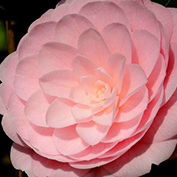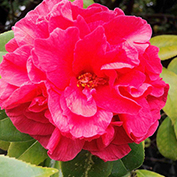
The camellia wood
In the Spring of 2010, a thorough study and classification of all of the camellias planted in the Gardens of Villa Melzi d’Eril over the course of the last 180 years was begun.
At this time there are around 250, that have taken root in different areas of the vast complex, but above all in the areas near the two entrances, from Loppia and from Bellagio. In the latter area, a large number of camellias has formed a small wood, above the small lake with its Japanese Maples, to the North. Many have grown from seeds and can be traced back to varieties of the type-species, camellia japonica. However, a conspicuous number of the plants are varieties of great historical and botanical interest, deriving from cultivars created during the golden age of Italian camellias, in the 19th century. Worthy of particular note is the presence of numerous plants belonging to splendid and rare Italian varieties, such as Lavinia Maggi (1858), Il Tramonto (circa 1856), Roma Risorta (circa 1866), Valtevareda (1851), Vergine di Colle Beato (circa 1856), Angela Cocchi (circa 1856), and Ridolfi Striata (1842).

The historic camellias of Villa Melzi d’Eril
In the mid-19th century, the Gardens of Bellagio – which already harboured great botanical wealth, featuring trees and bushes of all kinds, with approximately 230 different rose varieties – was considered one of the leading aristocratic cultivations of camellias, giving rise to a collection of young potted specimens, including: Pomponia Alba (bred in China in 1822), Duchesse d’Orléans (Milan, 1839), Preston Eclipse (England, 1837), Rosa Mundi (England, 1827) and many others.
These plants were cultivated in greenhouses, before being planted out at the right moment in the area devoted exclusively to the camellias, “near the Palace towards North”, as recent research has revealed. Here, distributed in three groups, forty-one different camellias took root, at least one of which has survived to the present day. This is a camellia japonica of the Atrorubens variety from China, which came to Europe in 1818. Towards 1840 a specimen was purchased by the Melzi d’Erils, which is still growing and flowering without any difficulty on the North side of the villa, in the company of other camellias planted there in later times.
 The camellias of the Italian nobility
The camellias of the Italian nobility
The 19th century was the era of glory of the camellia, reaching its peak between the 1820s and 1860s, often thanks to the direct involvement of illustrious owners of villas and gardens, belonging to the aristocracy, or of the most expert horticulturalists such as the Mercatellis of Florence and the Rovellis of Pallanza, to mention just the Italians.
The noble and mighty owners of Lake Como villas could hardly stay out of the competition: the Sachsen-Meiningens at Tremezzo and the Melzi d’Erils at Bellagio. And so, in many cases, the new varieties obtained after lengthy experimental breeding were dedicated to members of the noble families which, in various ways, had contributed to the spread of this kind of ornamental plant.
On the occasion of the annual ‘Camellias on Lake Como Day’, first organised for Spring 2011, when all of Italy was celebrating the 150th anniversary of the Unification of Italy, Villa Melzi d’Eril decided to adopt a theme in line with the historical and cultural traditions of the place. This collection of mainly 19th-century camellias was therefore organised, dedicated to members of the nobility of the time: Conte Cavor (1881), Conte Carlo Annoni (1888), Conte Cicogna (1852), Duchessa Melzi d’Eril (1883), Marchesa Margherita Serra (1860) and others still.
On the meadow overlooking the camellias of the Italian nobility, a second collection of historical camellias has allowed a historical bond between Lake Como and Lake Maggiore, a shared passion for camellias, to be renewed.
The Rovelli family of gardeners was engaged in the mid-19th century in the care of the Borromeo gardens on both Isola Bella and Isola Madre. Around 1851, Renato Rovelli and his brothers founded a “Horticulture Establishment” at Pallanza, cultivating thousands of ornamental plants. One of their greatest successes was the creation of new varieties of camellias, which were also highly regarded by the Melzi d’Erils. Their field of action was the Pallanza nursery, which, however, after the family died out, became a weed-infested wood. In 2003, a group of experts decided to explore this historical wood, bringing to light old Rovelli specimens. These camellias were patiently identified, catalogued and reproduced from cuttings. In 2011, Villa Melzi acquired some of the cuttings, which were later planted, thus contributing to increase the already remarkable wealth of camellias present since the mid-19th century. Among these must be noted the Angelo Botti, Comte de Gomer, Annessione, and Sacco Vera varieties.
By the Loppia entrance
In nature, the widest spread camellia in the Gardens is the camellia japonica, which grows spontaneously in southern China, Taiwan, Korea and the Japanese islands as far North as Honshū.
It is often present in the form of a small tree, which at times reaches 9 metres in height, with rich evergreen foliage of shiny coriaceous leaves. The flowers have 5-7 petals of a dark red colour, with a tuft of yellow stamens at the centre, which often become thin coloured filaments known as petaloids, which can also become true petals. Not only, but the basic red colour can also change to pink or white, forming variegations and mottling, which over the centuries have been exploited by breeders to create new varieties – known as cultivars – with widely varying features. This explains the extremely large number of ‘new’ camellias, which have invaded gardens the world over, leaving the natural species rather neglected.
If, in 1845, it was estimated that 700 cultivars of camellia japonica existed, today there are no less than 20,000, even though only a part of this number is available on the market. In this group, which stands near the Loppia entrance, we can admire above all Italian varieties created in the 19th century.


